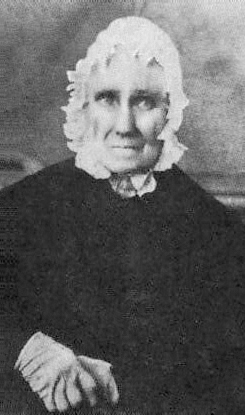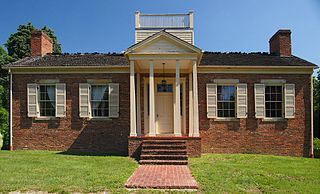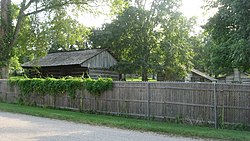
Spencer County is a county located in the U.S. state of Indiana. As of the 2020 census, the population was 19,810. The county seat is Rockport. Despite not being in the Owensboro Metropolitan Area, the entire riverfront of the city of Owensboro, Kentucky borders the southern tip of the county.

Rockport is a city in Ohio Township and the county seat of Spencer County, Indiana, along the Ohio River. The population was 2,270 at the 2010 census. Once the largest community in Spencer County, the city has recently been surpassed by the town of Santa Claus. At 37°53'1" north, Rockport is also the southernmost city in the state, located slightly south of Evansville, Cannelton, or Mount Vernon.
Lincoln City is an unincorporated community in Carter Township, Spencer County in the southwestern part of the U.S. state of Indiana. It lies five minutes south of Interstate 64, northeast of Evansville, and approximately twenty miles north of the Ohio River.

Thomas Lincoln was an American farmer, carpenter, and father of the 16th president of the United States, Abraham Lincoln. Unlike some of his ancestors, Thomas could not write. He struggled to make a successful living for his family and faced difficult challenges in Kentucky real estate boundary and title disputes, the early death of his first wife, and the integration of his second wife's family into his own family, before making his final home in Illinois.
Nancy Hanks Lincoln was the mother of U.S. President Abraham Lincoln. Her marriage to Thomas Lincoln also produced a daughter, Sarah, and a son, Thomas Jr. When Nancy and Thomas had been married for just over 10 years, the family moved from Kentucky to western Perry County, Indiana, in 1816. When Spencer County was formed in 1818, the Lincoln Homestead lay within its current boundaries. Nancy Lincoln died from milk sickness or consumption in 1818 at the Little Pigeon Creek Community in Spencer County when Abraham was nine years old.

Abraham Lincoln Birthplace National Historical Park is a designated U.S. historic park preserving two separate farm sites in LaRue County, Kentucky, where Abraham Lincoln was born and lived early in his childhood. He was born at the Sinking Spring site south of Hodgenville and remained there until the family moved to the Knob Creek Farm northeast of Hodgenville when he was two years old, living there until he was seven years of age. The park's visitor center is located at the Sinking Spring site.
Mordecai Lincoln was an uncle of U.S. President Abraham Lincoln. He was the eldest son of Captain Abraham Lincoln, a brother of Thomas Lincoln and Mary Lincoln Crume, and the husband of Mary Mudd. Lincoln is buried at the Old Catholic or Lincoln Cemetery near Fountain Green, Illinois.

Lincoln Boyhood National Memorial is a United States presidential memorial and a National Historic Landmark District in Lincoln City, Indiana. It preserves the farm site where Abraham Lincoln lived with his family from 1816 to 1830. During that time, he grew from a 7-year-old boy to a 21-year-old man. His mother, Nancy Hanks Lincoln, and at least 27 other settlers were buried here in the Pioneer Cemetery. His sister Sarah Lincoln Grigsby was buried in the nearby Little Pigeon Baptist Church cemetery, across the street at Lincoln State Park.

Abraham Lincoln was born on February 12, 1809, in a one-room log cabin on the Sinking Spring farm, south of Hodgenville in Hardin County, Kentucky. His siblings were Sarah Lincoln Grigsby and Thomas Lincoln, Jr. After a land title dispute forced the family to leave in 1811, they relocated to Knob Creek farm, eight miles to the north. By 1814, Thomas Lincoln, Abraham's father, had lost most of his land in Kentucky in legal disputes over land titles. In 1816, Thomas and Nancy Lincoln, their nine-year-old daughter Sarah, and seven-year-old Abraham moved to what became Indiana, where they settled in Hurricane Township, Perry County, Indiana.

The Lincoln Log Cabin State Historic Site is an 86-acre (0.3 km²) history park located eight miles (13 km) south of Charleston, Illinois, U.S., near the town of Lerna. The centerpiece is a replica of the log cabin built and occupied by Thomas Lincoln, father of U.S. President Abraham Lincoln. Abraham Lincoln never lived here and only occasionally visited, but he provided financial help to the household and, after Thomas died in 1851, Abraham owned and maintained the farm for his stepmother, Sarah Bush Lincoln. The farmstead is operated by the Illinois Historic Preservation Agency.
The Lincoln Trail Homestead State Park and Memorial is a 162-acre (66 ha) state park located on the Sangamon River in Macon County near Harristown, Illinois, United States.

Sarah Bush Lincoln was the second wife of Thomas Lincoln and stepmother of Abraham Lincoln. She was born in Kentucky to Christopher and Hannah Bush. She married her first husband, Daniel Johnston, in 1806, and they had three children. Daniel Johnston died in 1816, and in 1819, she married widower Thomas Lincoln, joining his family with her three children.

Lincoln State Park is a state park of Indiana, United States. It is located in southern Indiana in Spencer County approximately 35 miles (56 km) east of Evansville.
Jesse LaFollette was the grandfather of Robert Marion La Follette, Sr., William La Follette, and Harvey Marion LaFollette. His family lived next to the Knob Creek Farm, Kentucky owned by Thomas Lincoln during Abraham Lincoln's boyhood years. LaFollette is shown in one of the limestone panels at the Lincoln Boyhood National Memorial in Lincoln City, Indiana.

Little Pigeon River or Little Pigeon Creek is a stream located in northwestern Spencer County and northeastern Warrick County, Indiana. The 1,000 acre watershed feeds marshland which, when the stream is high, provides a good habitat for ducks. It was the site of the Little Pigeon Creek Community, Abraham Lincoln's Indiana boyhood home, now the Lincoln Boyhood National Memorial.

Little Pigeon Creek Community, also known as Little Pigeon Creek Settlement and Little Pigeon River settlement, was a settlement in present Carter and Clay Townships, Spencer County, Indiana along Little Pigeon Creek. The community, in the area of present-day Lincoln City, Indiana, was established from frontier land by 1816. There were sufficient settlers to the Indiana wilderness that it became a state in December, 1816.

Colonel William Jones House, also known as William Jones State Historic Site, is a historic house in Gentryville and the Lincoln State Park in Jackson Township, Spencer County, Indiana. It was listed on the National Register of Historic Places on May 12, 1975. William Jones (1803–1864) was a farmer, merchant, soldier, and politician.













